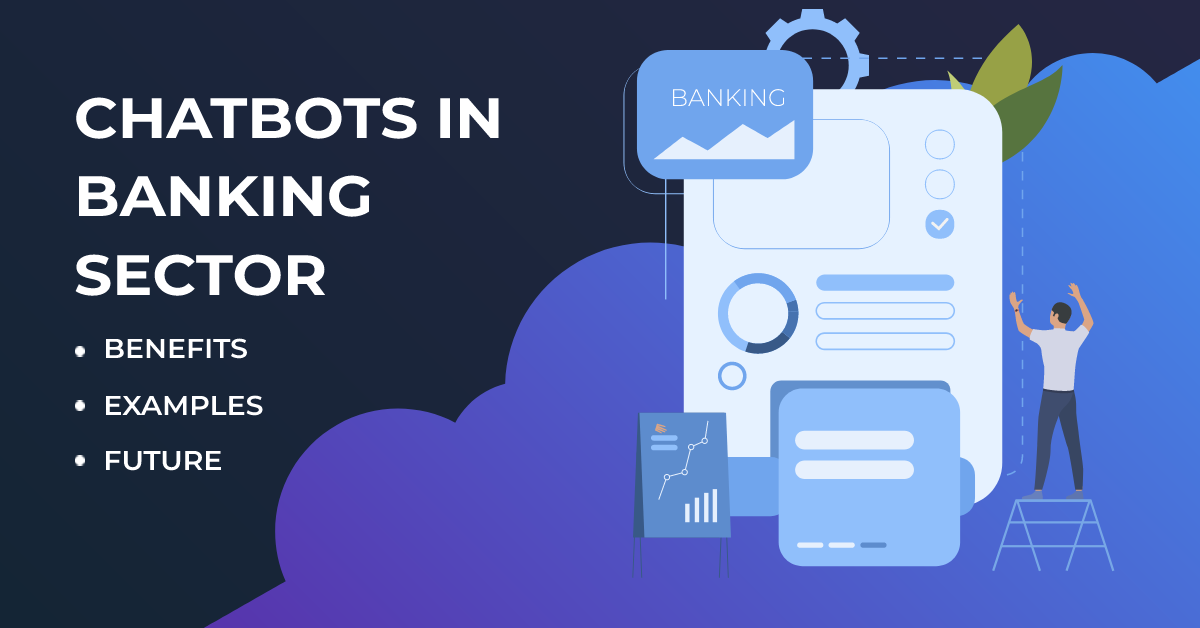Chatbots in Banking Sector: Benefits, Examples, and Future

4 min read | By Postpublisher P | 04 April 2023 | Technology
The use of chatbots in the banking sector has seen a significant increase in recent years. Chatbots provide a range of benefits such as improved customer service, cost savings, and increased efficiency. This article will explore the benefits, examples, and future of chatbots in the banking sector, as well as the challenges and limitations associated with their use.
So, let’s proceed……
Chatbots in banking sector
Chatbots in the banking sector refer to computer programs that use artificial intelligence and natural language processing to simulate conversation with customers via text or voice interfaces. They are designed to provide information, answer customer queries, and perform various banking tasks such as balance inquiry, fund transfer, bill payments, and more.
Brief overview of chatbots in banking sector
Chatbots have revolutionized the banking sector by providing an efficient and cost-effective way to offer customer service, automate routine tasks, and personalize customer experiences. It’s not a hard nut to crack to integrate them into banking apps, websites, and messaging platforms such as WhatsApp, Facebook Messenger, and WeChat.
Chatbots in the banking sector have been increasingly adopted by banks worldwide, offering a range of services from balance inquiries and fund transfers to fraud detection and financial advice. They have also improved customer satisfaction and reduced wait times, providing a better overall banking experience. It has increased the demand of these AI technology based chatbots for the business person. So, if you are one of those business people who are willing to expand their business, it’s advisable to hire Chatbot Development Company of the trustworthy software development companies worldwide.
Benefits of Chatbots in Banking Sector
Improved Customer Service
Chatbots are able to provide instant and accurate responses to customer queries and concerns, improve the quality and speed of customer service. They can also offer personalized support by analyzing customer data and providing tailored solutions to individual needs.
24/7 Availability
Chatbots are available around the clock to- ➤Provide customers with continuous support ➤Eliminate the need for live customer service agents ➤To be available at all times ➤To enable customers to access banking services at any time, regardless of their location or time zone.
Personalization and Customization
Chatbots can analyze customer data and provide personalized banking recommendations and advice based on the customer’s needs, preferences, and financial goals. This enables customers to receive customized banking services, creating a more personalized and satisfying customer experience.
Cost Savings
Chatbots are a cost-effective solution for banks as they- ➤Require minimal maintenance ➤Have lower operational costs than human representatives ➤Supports a large influx of calls or emails from customers ➤Reduce the cost of providing customer service ➤Increase profitability for the bank
Increased Efficiency
Chatbots can automate routine tasks such as account balance inquiries, fund transfers, and bill payments, allowing bank employees to focus on more complex tasks. This increases the efficiency of banking operations, reduces wait times for customers, and enhances the overall banking experience.
Examples of Chatbots in Banking Sector
𝐁𝐚𝐧𝐤 𝐨𝐟 𝐀𝐦𝐞𝐫𝐢𝐜𝐚’𝐬 𝐄𝐫𝐢𝐜𝐚 – Erica is an AI chatbot solution developed by Bank of America to provide personalized banking services to its customers. It can help customers manage their finances, track their spending, pay bills, and make transactions. It also provides alerts and recommendations to customers based on their financial behavior.
𝐂𝐚𝐩𝐢𝐭𝐚𝐥 𝐎𝐧𝐞’𝐬 𝐄𝐧𝐨 – Eno is a chatbot developed by Capital One to help customers manage their finances. It provides instant account information, enables customers to make payments, and helps customers track their spending. It can also detect fraud and notify customers of suspicious activity.
𝐇𝐃𝐅𝐂 𝐁𝐚𝐧𝐤’𝐬 𝐄𝐕𝐀 – EVA (Electronic Virtual Assistant) is a chatbot developed by HDFC Bank to provide customers with banking services. It can help customers with banking transactions, provide account information, and offer investment advice. It also has the ability to understand and respond to customer queries in multiple languages.
𝐉𝐏𝐌𝐨𝐫𝐠𝐚𝐧 𝐂𝐡𝐚𝐬𝐞’𝐬 𝐂𝐎𝐢𝐍 – COiN (Contract Intelligence) is an AI-powered chatbot developed by JPMorgan Chase to automate its contract review process. It can review legal documents, highlight key terms, and identify potential issues. It has helped the banks a lot to save time and reduce errors in the contract review process.
𝐖𝐞𝐥𝐥𝐬 𝐅𝐚𝐫𝐠𝐨’𝐬 𝐆𝐫𝐞𝐞𝐧𝐡𝐨𝐮𝐬𝐞 – Greenhouse is a chatbot developed by Wells Fargo to provide financial advice to its customers. It can help customers create and manage their budget, track their spending, and set financial goals. It also provides customers with personalized financial coaching and guidance.
Future of Chatbots in Banking Sector
𝐀𝐝𝐯𝐚𝐧𝐜𝐞𝐦𝐞𝐧𝐭𝐬 𝐢𝐧 𝐀𝐈 𝐚𝐧𝐝 𝐌𝐚𝐜𝐡𝐢𝐧𝐞 𝐋𝐞𝐚𝐫𝐧𝐢𝐧𝐠 – As AI and machine learning technologies continue to evolve, chatbots are expected to become even more intelligent and sophisticated. With AI Development company They will be able to provide more personalized banking services, anticipate customer needs, and make more accurate financial recommendations.
𝐈𝐧𝐜𝐫𝐞𝐚𝐬𝐞𝐝 𝐀𝐝𝐨𝐩𝐭𝐢𝐨𝐧 𝐑𝐚𝐭𝐞𝐬 – Chatbots are expected to become increasingly popular in the banking sector as more banks adopt them to improve their customer service, increase efficiency, and reduce costs. This is expected to lead to a greater demand for chatbot developers and AI experts.
𝐈𝐧𝐭𝐞𝐠𝐫𝐚𝐭𝐢𝐨𝐧 𝐰𝐢𝐭𝐡 𝐎𝐭𝐡𝐞𝐫 𝐓𝐞𝐜𝐡𝐧𝐨𝐥𝐨𝐠𝐢𝐞𝐬 – Chatbots are expected to be integrated with other technologies such as blockchain, biometrics, and voice recognition to provide even more advanced banking services. This could enable customers to securely store and transfer their financial data, authenticate their identities, and perform banking transactions using their voice.
𝐂𝐡𝐚𝐭𝐛𝐨𝐭𝐬 𝐢𝐧 𝐈𝐧𝐯𝐞𝐬𝐭𝐦𝐞𝐧𝐭 𝐁𝐚𝐧𝐤𝐢𝐧𝐠 – Chatbots are expected to be used more extensively in investment banking to provide financial advice, make investment recommendations, and assist with financial analysis. This could help banks to better understand market trends, provide more accurate financial forecasts, and offer more personalized investment advice to their customers.
𝐂𝐡𝐚𝐭𝐛𝐨𝐭𝐬 𝐚𝐬 𝐚 𝐓𝐨𝐨𝐥 𝐟𝐨𝐫 𝐅𝐢𝐧𝐚𝐧𝐜𝐢𝐚𝐥 𝐄𝐝𝐮𝐜𝐚𝐭𝐢𝐨𝐧 – Chatbots are expected to play an increasingly important role in financial education, providing customers with information on financial literacy, budgeting, and investment strategies. This could help customers to better manage their finances and make more informed financial decisions.
Challenges and Limitations of Chatbots in Banking Sector
𝐒𝐞𝐜𝐮𝐫𝐢𝐭𝐲 𝐚𝐧𝐝 𝐏𝐫𝐢𝐯𝐚𝐜𝐲 𝐂𝐨𝐧𝐜𝐞𝐫𝐧𝐬 – Chatbots in the banking sector deal with sensitive customer information such as financial data and personal details. Therefore, ensuring the security and privacy of this data is a major concern. Banks need to implement strict security measures to prevent unauthorized access to customer data and ensure that chatbots are compliant with data protection regulations.
𝐋𝐚𝐧𝐠𝐮𝐚𝐠𝐞 𝐚𝐧𝐝 𝐂𝐮𝐥𝐭𝐮𝐫𝐚𝐥 𝐁𝐚𝐫𝐫𝐢𝐞𝐫𝐬 – Chatbots may not always be able to understand and respond to customer queries accurately due to language and cultural barriers. This could result in misunderstandings and frustrate customers. Banks need to ensure that their chatbots are programmed to understand and respond to different languages and cultural nuances.
𝐓𝐞𝐜𝐡𝐧𝐢𝐜𝐚𝐥 𝐆𝐥𝐢𝐭𝐜𝐡𝐞𝐬 𝐚𝐧𝐝 𝐄𝐫𝐫𝐨𝐫𝐬 – Chatbots in the banking sector are dependent on technology and may experience technical glitches and errors. This could lead to unsatisfactory customer experiences and damage the reputation of the bank. Banks need to ensure that their chatbots are regularly tested and maintained to prevent technical issues.
𝐌𝐚𝐢𝐧𝐭𝐞𝐧𝐚𝐧𝐜𝐞 𝐚𝐧𝐝 𝐔𝐩𝐤𝐞𝐞𝐩 𝐂𝐨𝐬𝐭𝐬 – Chatbots require regular maintenance and updates to ensure that they are operating effectively. This can be costly for banks, especially if they have multiple chatbots operating simultaneously. Banks need to carefully consider the maintenance and upkeep costs associated with chatbots before implementing them.
𝐇𝐮𝐦𝐚𝐧 𝐈𝐧𝐭𝐞𝐫𝐯𝐞𝐧𝐭𝐢𝐨𝐧 𝐚𝐧𝐝 𝐄𝐱𝐩𝐞𝐫𝐭𝐢𝐬𝐞 – Chatbots may not always be able to address complex customer queries that require human intervention and expertise. Banks need to ensure that there are procedures in place to escalate queries to human representatives when required. They also need to ensure that their human representatives have the necessary expertise to address complex customer queries effectively.
Conclusion
In conclusion, chatbots have become an integral part of the banking sector, providing a range of benefits such as improved customer service, 24/7 availability, personalization and customization, cost savings, and increased efficiency. There are multiple examples of successful chatbots in the banking sector such as Bank of America’s Erica, Capital One’s Eno, HDFC Bank’s EVA, JPMorgan Chase’s COiN, and Wells Fargo’s Greenhouse. The future of chatbots in the banking sector looks promising, with advancements in AI chatbot development and machine learning, increased adoption rates, integration with other technologies, and their use in investment banking and financial education.
However, there are also challenges and limitations such as security and privacy concerns, language and cultural barriers, technical glitches and errors, maintenance and upkeep costs, and the need for human intervention and expertise. As technology continues to evolve, banks need to carefully consider the benefits and limitations of chatbots to ensure that they provide customers with the best possible banking experience.
The latest from our editors
Join over 150,000+ subscribers who get our best digital insights, strategies and tips delivered straight to their inbox.


